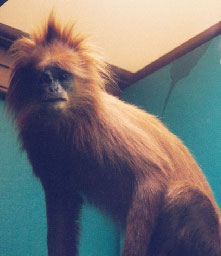This species has a sacculated stomach to assist in the breakdown of cellulose. In the forestomach there are microbes that break down cellulose into fatty acids by anaerobic fermentation (Davies et al., 1988). The microbes in the forestomach also detoxify alkaloid defense chemicals in plants (Davies et al., 1988). The maroon leaf-monkey has enlarged salivary glands. This species has a dental formula of 2:1:2:3 on both the upper and lower jaws (Ankel-Simons, 2000). The incisors are narrow and the molars have sharp, high crests (Oates and Davies, 1994). The jaw is deep and the face is short and broad (Oates and Davies, 1994). The pollex (thumb) is reduced in this species (Davies, 1991). The orbits are widely spaced and the hindlimbs are longer as compared to the forelimbs (Oates and Davies, 1994). The average body mass for adult males is 6.290 kilograms and for adult females it is 6.170 kilograms (Fleagle, 1999). The pelage color ranges from red to reddish-orange with the stomach region being a lighter shade and the hands and tip of the tail being darker shades.
This species has five subspecies (Napier and Napier, 1967):
- Presbytis rubicunda rubicunda
- Presbytis rubicunda rubidus
- Presbytis rubicunda ignitus
- Presbytis rubicunda carimatae
- Presbytis rubicunda chryseus
